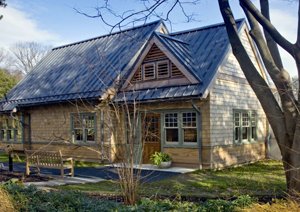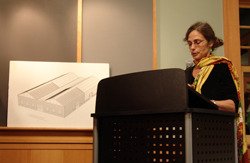New Wister Center Awarded Gold LEED Certification

The Scott Arboretum's Wister Education Center and Greenhouse, which opened last fall, recently received gold LEED certification for new construction from the U.S. Green Building Council. The award - which identifies the Center as a "pioneering example of sustainable design" - is the culmination of an effort that began during the earliest stages of the project.
"I feel a real sense of pride that the educational and horticultural work of the Arboretum is housed in a way that exemplifies beautiful and sustainable design and a sensible use of resources," says Scott Arboretum Director Claire Sawyers. "While we aim to inspire good gardening efforts at a grassroots, regional level, this building demonstrates the Arboretum and College also aim to inspire careful stewardship of the planet as the ultimate garden."
"I am very pleased to extend my congratulations to Claire and her team for working so diligently to make the Wister Center a model of green design," adds President Rebecca Chopp. "Our community is increasingly enriched by the excellent work and care that this facility fosters."

Construction and design of the 5,200-square foot structure - including a classroom, exhibit areas, greenhouse, and support space - focused on innovative energy efficient green building techniques. One technique is the reuse of Metasequoia glyptostroboides (dawn redwood) trees that were cut down during the construction of Alice Paul Hall. The harvested trees were made into shingles that were used for almost a third of the Center's siding. Another technique involved the use of concrete containing fly ash, a byproduct of coal-fired power plants that is usually dumped in landfills.
The building also uses an energy-efficient lighting system. The design opens the building to daylight as much as possible using large windows and “light tubes” that bring light down through the ceiling. Energy-efficient fluorescent bulbs are controlled by occupancy sensors and a building-wide timing system. A green roof is planned and storm water runoff is directed into a cistern used for watering plants surrounding the building.


